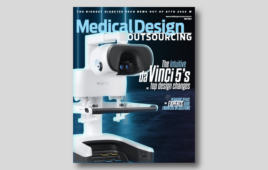
This is a side-by-side look at platinum (left) and glassy carbon (right) thin-film electrodes for deep brain stimulation. [Image from SDSU]
The researchers developed a carbon version of deep brain stimulation electrodes that are designed to last longer in the brain without corroding. Metal electrodes typically degrade after 100 million cycles of electrical impulses while the glassy carbon version can survive 3.5 billion cycles. The carbon design also doesn’t react to MRI scans.
Deep brain stimulation (DBS) is gaining traction in the use of treatment for movement disorders that don’t respond to medication, such as Parkinson’s disease, tremors and uncontrolled muscle contractions, according to the researchers. It is also being considered for use in traumatic brain injury, addiction, dementia, depression and other conditions.
Electrodes used in DBS have traditionally been made out of thin-film platinum or iridium oxide. However, the metal-based electrodes produce heat and can interfere with the MRI images by creating bright spots that block areas of the brain from being viewed. They can also become magnetized and move when patients receive scans, which can cause discomfort.
“Our lab testing shows that unlike the metal electrode, the glassy carbon electrode does not get magnetized by the MRI, so it won’t irritate the patient’s brain,” Surabhi Nimbalkar, first author on the study, said in a news release.
The carbon electrode reads chemical and electric signals from the brain. Metal electrodes are only able to read electrical signals.
“It’s supposed to be embedded for a lifetime, but the issue is that metal electrodes degrade, so we’ve been looking at how to make it last a lifetime,” Sam Kassegne, senior author on the study, said. “Inherently, the carbon thin-film material is homogenous – or one continuous material – so it has very few defective surfaces. Platinum has grains of metal which become the weak spots vulnerable to corrosion.”
The carbon electrodes were tested using precise measurements of vibrations during MRI scans to make sure it was safer and a better alternative to metal ones.
“I was excited to see that our vibration measurement instrument enables this completely new benchmarking of real electrodes, which facilitates the risk analysis,” Erwin Fuhrer, first author on the study, said.
Rassegne has spent 10 years developing the thin-film carbon, but recently started customizing it for neurological applications when University of Washington and Massachusetts Institute of Technology collaborators reached out to him about micro- and nano-fabrication technologies.
Jan Korvink, who works on MRI technologies for the brain and MRI microscopy, collaborated with Kassegne on making the carbon-based electrodes.
“Inventing ways to make the MRI machine see more details of the brain is our key mission,” Korvink, senior author on the study, said.
“We scanned the electrodes using different imaging sequence techniques and found glassy carbon causes much less distortion of the image,” Marty Sereno, one of the researchers, said. “Metal disturbs the magnetic field which causes distortion, but carbon fiber has less induced currents in the magnetic field, so it won’t exert any force on the electrode itself, which is an advantage because it’s embedded in the soft tissue of the brain.”
The research team plans to test the carbon electrode in patients and work on testing different forms of carbon to be used in new electrodes.
The research was published in the Nature Microsystems & Nanoengineering journal and was developed by San Diego State University engineers in collaboration with researchers at KIT in Germany.




